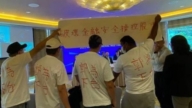【新唐人2012年8月18日讯】中国经济7月宏观资料呈现增长疲软,7月居民消费价格指数(CPI)同比涨幅下滑至两年半谷底,粉碎了一些经济学家预计:经济年中触底反弹的乐观判断。各金融机构开始调整对于中国2012年全年GDP增长8%到9%的预期。各地开始了以“稳增长”为招牌的各类上马专案自救。专家指出,中共的经济政策方向已经错误,现在还企图通过所谓“地方版四万亿”制造经济繁荣的假相,只会让中国老百姓陷入更深的痛苦。
大陆统计局消息,7月居民消费价格指数(CPI)同比涨幅下滑至两年半谷底,同时,进出口增速双双下跌,出口增速为1%,远低于6月的11.3%水准,而进口增速为4.7%,也低于6月的6.3%增幅﹔与此同时,工业增加值与固定资产投资等关键资料,也低于市场预期,中国经济实体层面硬着陆已经开始。
为了维持所谓的“稳增长”,各地方政府出台了刺激经济增长的各种投资计划,外界称之为“地方版四万亿”。
不过,这些计划还是着眼于基础建设,铁路建设依然是地方政府的首选。例如武汉在“十二五”期间,将重点建设82个交通建设项目,总投资3131.49亿元。
经济学家茅于轼指出,这种企图用“增加投入”而“增加产出”的思路,已经行不通。他说中国的经济整体呈现“浪费”的严重现象,而金融系统的“烂账现象”已经形成巨大隐患。
经济学家茅于轼:“方向搞错了,增加投入不是方向,要提高效率才是方向,投入很高,产出很少,那就是赔钱,赔钱就是一个窟窿,一个窟窿的话,不但不解决当前的困难,反而把困难往后推了,将来还窟窿还不出来,那是大问题啦。”
美国“南卡罗来纳大学艾肯商学院”教授谢田说,09年为了刺激经济,中共中央政府投入的四万亿,导致了今天的通货膨胀,而当今当局为了保持所谓的GDP增长,还在采取同样的手法。
美“南卡罗来纳大学艾肯商学院”教授谢田:“盲目的投资,在进行的时候,一定成为中共官员中饱私囊的一个工具,这就是他们为什么乐此不疲,一而再、再而三的进行这种重复的、浪费的、无效益的投资,关键对整个社会造成恶劣的恶影响,进一步加强资产的泡沫,进一步加大中国的通货膨胀 。”
英国《金融时报》专栏作家徐瑾说,当年的四万亿,主要通过政府财政与银行融资支撑资金来源,中央所出部分不足当年GDP总量的5%﹔目前地方版四万亿资金来源还不明确,而刺激力度也令人错愕。
大陆目前不时听到某地方政府将要破产的传言。徐瑾指出,地方政府也是市场的主要玩家,在他们日子不好过的情况下,要小心他们画一个大饼,作为获得各方政策和资金支持的政绩资本。
而谢田表示,地方版四万亿会导致又一次GDP大跃进。
谢田:“它为了保证GDP的增长,它可以去借钱、可以大印钞票、可以从各种地方融资来那种虚假的、泡沫化的经济投资,基建投资,所以这个数字它想要做到的话,一定能做到,做不到它有其他的办法,弄虚作假的办法能达到。”
反观地方版四万亿,长沙的刺激计划目标是8000亿,不过长沙市去年全年的地方财政总收入才668.11亿元。根据媒体报导,长沙市上半年重点工程投资完成额只有年度计划的31%,重大商务专案累计投资额只有年度计划的21.78%。
徐瑾表示,地方政府的如意算盘不外乎是:以区域政策和产业政策结合,争取专案规划,一旦获得发改委审批之后,依靠招商引资、各种优惠条件吸引外来资金,政府自己却拿不出多少真金实银。
采访编辑/刘惠 后制/周天
“Local Version of 4 Trillion Yuan Plan” Launched in China
Economic data for July 2012 revealed weak growth in China.
The year-to-year growth in the CPI data
fell to a two-and-half year low in July.
This drop has shattered some economists’ expectation
of the economy bouncing back in the middle of this year.
Financial institutions began to adjust their China
forecast of between 8% and 9% GDP growth in 2012.
Local Chinese Communist Party (CCP) authorities have
launched plans to stimulate and “stabilize economic growth”.
Experts say China’s economic
policy has gone the wrong way.
Official attempts to use the “local version of
4 Trillion yuan plan,”
which will create fake economic prosperity will only
entrap Chinese civilians into deeper problems.
China’s official data showed the CPI year-on-year growth
rate for July dropped to it’s lowest in two and a half years.
The growth of both import and export has fallen, too.
Exports grew by 1%, far below the 11.3% in June.
Imports rose by 4.7%, less than the 6.3% in June.
Industrial added value and fixed asset investments
were all below market expectations.
The hard landing for China’s economy has begun.
In order to stabilize economic growth, local CCP
authorities have launched a variety of investment projects to push the economy forward.
These are known as “the local version of
the 4 Trillion yuan plan”.
The plan aims at infrastructure construction,
with railway construction the preferred choice.
For example, in Wuhan, there will be a focus
on the construction of 82 transportation projects.
This will involve an investment of over 313 Billion yuan.
Economist Mao Yushi has said that the approach to
“increase output" by “increasing investment" cannot work.
China’s overall economy has presented a serious “waste”.
Bad debt factors in the financial system have
caused potential hazards, according to Mao Yushi.
Mao Yushi: “It’s a wrong way to increase investment.
It should improve efficiency.
With high input and very little output, that will lose money,
and form a hole that postpones current difficulties.
It will be a bigger problem in the future
if the hole is unplugged.”
Xie Tian is Assistant Professor
at the University of South Carolina Aiken.
He remarked on the CCP’s economic stimulus policy.
In 2009, its 4 Trillion yuan stimulation
plan led to today’s inflation.
Now the regime still uses the same
method to maintain GDP growth.
Xie Tian: “The blind investment has inevitably become
a tool for the CCP officials to fill their own pockets.
That’s why they’ve never been reluctant to launch
repeated, wasteful and unproductive investment.
The bad effects have been exerted on the entire community.
It has further fuelled the asset bubble and China’s inflation."
Xu Jin, columnist of the UK’s Financial Times,
commented that in 2009, the 4 Trillion yuan plan
was funded by fiscal revenue and bank loans.
The currency taken out by CCP central authorities
accounted for less than 5% of GDP in 2009.
The source of capital for “the local 4 Trillion yuan”
is still unknown, according to Xu Jin’s commentary.
Rumors have raised in China that some
local authorities could go bankrupt.
Xu Jin said that local authorities
are also major market players.
Xu Jin warned that they have exaggerated political
achievements to gain favorable policies and financial support.
Xie Tian believes that the local version of the 4 Trillion yuan
plan would lead to another great leap forward of GDP.
Xie Tian: “In order to maintain GDP growth, it has sought
bank loans, undertaken a lot of money printing,
and used various funding sources.
The money went to infrastructure and phony investments.
So it can achieve the figure it sets,
falsification will surely help to make it.”
The target of the stimulation plan for Changsha authorities
is an investment of 800 Billion yuan.
The city’s 2011 fiscal revenue was only 66.8 Billion yuan.
The media reported that in Changsha in the first half of 2012,
only 31% of total key projects were fully-funded.
The total investment on major business projects
only reached 21.78% of the yearly budget.
According to Xu Jin’s speculation, local CCP authorities
would probably still utilize local and industrial policies to attract foreign capital.
The local authorities would still be poor in the funding.




























